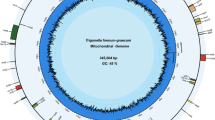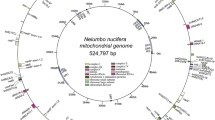Abstract—In this study, the complete mitochondrial genome (mt genome) of Triosteum pinnatifidum was investigated for the first time. The mt genome was consisted of 803 609 bp, comprised of 62 genes including 19 tRNA genes, 3 rRNA genes and 40 protein-coding genes. We detected protein-coding genes and codon usage, RNA editing sites and repeat sequences. The protein-coding genes substitution rates, DNA segments migration, comparison of six species genomic features were generated. Phylogenetic analysis of 32 species was also taken. A total of 463 RNA editing sites were found in 40 protein-coding genes. Being slightly positive, the GC-skew and AT-skew are 0.0060 and 0.0004, respectively. Most of PCGs have Ka/Ks ratio less than 1, indicating the existence of purifying or negative selection in these genes. This is the first report mt genome in the family Caprifoliaceae and could provide a useful foundation for evolutionary analysis, molecular biology and taxonomy in genus Triosteum and other higher plants.





Similar content being viewed by others
REFERENCES
Altschul, S.F., Gish, W., Miller, W., Lipman, D.J., et al., Basic local alignment search tool, J. Mol. Biol., 1990, vol. 215, pp. 403–410. https://doi.org/10.1016/S0022-2836(05)80360-2
Au, K.F., Underwood, J.G., Lee, L., and Wong, W.H., Improving PacBio long read accuracy by short read alignment, PLoS One, 2012, vol. 7, pp. e46679. https://doi.org/10.1371/journal.pone.0046679
Baha, V.S., Behloul, N., Liu, Z.Z., Meng, J.H., et al., Comprehensive analysis of genetic and evolutionary features of the hepatitis E virus, BMC Genomics, 2019, vol. 20, p. 790. https://doi.org/10.1186/s12864-019-6100-8
Basse, C.W., Mitochondrial inheritance in fungi, Curr. Opin. Microbiol., 2010, vol. 13, pp. 712–719. https://doi.org/10.1016/j.mib.2010.09.003
Bell, C.D. and Donoghue, M.J., Dating the Dipsacales: comparing models, genes, and evolutionary implications, Am. J. Bot., 2005, vol. 92, pp. 284–296. https://doi.org/10.3732/ajb.92.2.284
Benson, G., Tandem repeats finder: a program to analyze DNA sequences, Nucleic Acids Res., 1999, vol. 27, pp. 573–580. https://doi.org/10.1093/nar/27.2.573
Bi, C.W., Paterson, A.H., Wang, X.L., Ye, N., et al., Analysis of the complete mitochondrial genome sequence of the diploid cotton Gossypium raimondii by comparative genomics approaches, BioMed Res. Int., 2016, vol. 18, pp. 2314–6133. https://doi.org/10.1155/2016/5040598
Caccone A., Gentile G., Burns C.E., Powell J.R., et al. Extreme difference in rate of mitochondrial and nuclear DNA evolution in a large ectotherm, Galápagos tortoises, Mol. Phylogenet. Evol., 2004, vol. 31, pp. 794–798. https://doi.org/10.1016/j.ympev.2004.02.004
Chai, X., Su, Y.F., Yan, S.L., and Huang, X., Chemical constituents of the roots of Triosteum pinnatifidum, Chem. Nat. Comp., 2014, vol. 50, pp. 1149–1152. https://doi.org/10.1007/s10600-014-1188-1
Chai, X., Su, Y.F., Zheng, Y.H., Yan, S.L., Zhang, X., and Gao, X.M., Iridoids from the roots of Triosteum pinnatifidum, Biochem. Syst. Ecol., 2010, vol. 38, pp. 210–212. https://doi.org/10.1016/j.bse.2009.12.037
Chang, S.X., Wang, Y.K., Lu, J.J., Zhao, T.J., et al., The Mitochondrial genome of soybean reveals complex genome structures and gene evolution at intercellular and phylogenetic levels, PLoS One, 2013, vol. 8, p. e56502. https://doi.org/10.1371/journal.pone.0056502
Chen, S., Zhou, Y.Q., Chen, Y., and Gu, J., fastp: an ultra-fast all-in-one FASTQ preprocessor, Bioinformatics, 2018, vol. 34, pp. i884–i890. https://doi.org/10.1093/bioinformatics/bty560
Cheng, Y., He, X.X., Priyadarshani, S.V.G.N., Wang, Y., et al., Assembly and comparative analysis of the complete mitochondrial genome of Suaeda glauca, BMC Genomics, 2021, vol. 22, pp. 167. https://doi.org/10.1186/s12864-021-07490-9
Cui, H.N., Ding, Z., Zhu, Q.L., Gao, P., et al., Comparative analysis of nuclear, chloroplast, and mitochondrial genomes of watermelon and melon provides evidence of gene transfer, Sci. Rep., 2021, vol. 11, p. 1595. https://doi.org/10.1038/s41598-020-80149-9
Darriba, D., Taboada, G.L., Doallo, R., and Posada, D., jModel Test 2: more models, new heuristics and parallel computing, Nat. Methods, 2012, vol. 9, p. 772. https://doi.org/10.1038/nmeth.2109
Gould, K.R. and Donoghue, M.J., Phylogeny and biogeography of Triosteum (Caprifoliaceae), Harv. Pap. Bot., 2000, vol. 5, pp. 157–166. https://doi.org/10.2307/41761600
Greiner, S., Lehwark, P., and Bock, R., Organellar Genome DRAW (OGDRAW) version1.3.1: expanded toolkit for the graphical visualization of organellar genomes, Nucleic Acids Res., 2019, vol. 47, pp. W59–W64. https://doi.org/10.1101/545509
Hausner, G., 6-fungal mitochondrial genomes, plasmids and introns, Appl. Mycol. Biotechnol., 2003, vol. 3, pp. 101–131. https://doi.org/10.1016/S1874-5334(03)80009-6
Huang, Z., Jin, S.H., Guo, H.D., Chen, Q.B., et al., Genome-wide identification and characterization of TIFY family genes in Moso Bamboo (Phyllostachys edulis) and expression profiling analysis under dehydration and cold stresses, PeerJ, 2016, vol. 4, p. e2620. https://doi.org/10.7717/peerj.2620
Kan, S.L., Shen, T.T., Gong, P.P., Wang, X.Q., et al., The complete mitochondrial genome of Taxus cuspidate (Taxaceae) eight protein coding genes have transferred to the nuclear genome, BMC Evol. Biol., 2020, vol. 20, p. 10. https://doi.org/10.1186/s12862-020-1582-1
Knoop, V., The mitochondrial DNA of land plants: peculiarities in phylogenetic perspective, Curr. Genet., 2004, vol. 46, pp. 123–139. https://doi.org/10.1007/s00294-004-0522-8
Koren, S., Walenz, B.P., Berlin, K., Phillippy, A.M., et al., Canu: scalable and accurate long-read assembly via adaptive k-mer weighting and repeat separation, Genome Res., 2017, vol. 27, pp. 722–736. https://doi.org/10.1101/gr.215087.116
Lenz, H., Rüdinger, M., Volkmar, U., Knoop, V., et al. Introducing the plant RNA editing prediction and analysis computer tool PREPACT and an update on RNA editing site nomenclature, Curr. Genet., 2010, vol. 56, pp. 189–201. https://doi.org/10.1007/s00294-009-0283-5
Liu, H.R., Gao, Q.B., Zhang, F.Q., Chen, S.L., et al., Gnentic diversity and phylogeographic structure of Triosteum pinnatifidumbased chloroplast DNA sequence rbcL-accD, Bull. Bot. Res., 2018a, vol. 38, pp. 278–283. https://doi.org/10.7525/j.issn.1673-5102.2018.02.016
Liu, H.R., Gao, Q.B., Zhang, F.Q., Khan, G., and Chen, S.L., Westwards and northwards dispersal of Triosteum himalayanum (Caprifoliaceae) from the Hengduan Mountains region based on chloroplast DNA phylogeography, PeerJ, 2018b, vol. 6, p. e4748. https://doi.org/10.7717/peerj.4748
Liu, H.R., Xia, M.Z., Xiao, Q.M., Zhang, D.J., et al., Characterization of the complete chloroplast genome of Linnaea borealis, a rare, clonal self-incompatible plant, Mitochondrial DNA, Part B, 2020, vol. B5, pp. 200–201. https://doi.org/10.1080/23802359.2019.1698995
Liu, H.R., Khan, G., Gao, Q., Zhang, F., Liu, W., Wang, Y., Fang, J., Chen, S., and Afridi, S.G., Dispersal into the Qinghai-Tibet plateau: evidence from the genetic structure and demography of the alpine plant Triosteum pinnatifidum, PeerJ, 2022, vol. 10, p. e12754. https://doi.org/10.7717/peerj.12754
Lowe, T.M. and Chan, P.P., tRNAscan-SE On-line: integrating search and context for analysis of transfer RNA genes, Nucleic Acids Res., 2016, vol. 44, pp. W54–W5. https://doi.org/10.1093/nar/gkw413
Lv, W.Q., Jiang, H.F., Bo, J., He, S.P., et al., Comparative mitochondrial genome analysis of Neodontobutis hainanensis and Perccottus glenii reveals conserved genome organization and phylogeny, Genomics, 2020, vol. 112, pp. 3862–3870. https://doi.org/10.1016/j.ygeno.2020.06.039
O’Conner, S. and Li, L., Mitochondrial fostering: The mitochondrial genome may play a role in plant orphan gene evolution, Front. Plant Sci., 2020, vol. 11, p. 600117. https://doi.org/10.3389/fpls.2020.600117
Perna, N.T. and Kocher, T.D., Patterns of nucleotide composition at fourfold degenerate sites of animal mitochondrial genomes, J. Mol. Evol., 1995, vol. 41, pp. 353–358. https://doi.org/10.1007/BF00186547
Plotkin, J.B. and Kudla, G., Synonymous but not the same: the causes and consequences of codon bias, Nat. Rev. Genet., 2011, vol. 12, pp. 32–42. https://doi.org/10.1038/nrg2899
Rhoads, A. and Au, K.F., PacBio sequencing and its applications, Genomics, Proteomics Bioinf., 2015, vol. 13, pp. 278–289. https://doi.org/10.1016/j.gpb.2015.08.002
Rödelsperger, C. and Sommer, R.J., Computational archaeology of the Pristionchus pacificus genome reveals evidence of horizontal gene transfers from insects, BMC Evol. Biol., 2011, vol. 11, p. 239. https://doi.org/10.1186/1471-2148-11-239
Rombel, I.T., Sykes, K.F., Rayner, S., and Johnston, S.A., ORF-FINDER: a vector for high-throughput gene identification, Gene, 2002, vol. 282, pp. 33–41. https://doi.org/10.1016/S0378-1119(01)00819-8
Rozewicki, J., Li, S., Amada, A.M., Katoh, K., et al., MAFFT-DASH: integrated protein sequence and structural alignment, Nucleic Acids Res., 2019, vol. 47, pp. W5–W10. https://doi.org/10.1093/nar/gkz342
Salmela, L. and Rivals, E., LoRDEC: accurate and efficient long read error correction, Bioinformatics, 2014, vol. 30, pp. 3606–3614. https://doi.org/10.1093/bioinformatics/btu538
Stamatakis, A., RAxML version 8: a tool for phylogenetic analysis and post-analysis of large phylogenies, Bioinformatics, 2014, vol. 30, pp. 1312–1313. https://doi.org/10.1093/bioinformatics/btu033
Taanman, J.W., The mitochondrial genome: structure, transcription, translation and replication, Biochim. Biophys. Acta, 1999, vol. 1410, pp. 103–123. https://doi.org/10.1016/s0005-2728(98)00161-3
Tang, D.F., Wei, F., Kashif, M.H., Zhou, R.Y., et al., Identification and analysis of RNA editing sites in chloroplast transcripts of kenaf (Hibiscus cannabinus L.), 3 Biotech., 2019, vol. 9, p. 361. https://doi.org/10.1007/s13205-019-1893-3
Tang, Y., Zheng, X., Liu, H., and Sunxie, F., Population genetics and comparative mitogenomic analyses reveal cryptic diversity of Amphioctopus neglectus (Cephalopoda: Octopodidae), Genomics, 2020, vol. 112, pp. 3893–3902. https://doi.org/10.1016/j.ygeno.2020.06.036
Wang, D.P., Zhang, Y.B., Zhang, Z., Yu, J., et al., KaKs_Calculator 2.0: A toolkit incorporating gamma-series methods and sliding window strategies, Genomics, Proteomics Bioinf., 2010, vol. 8, pp. 77–80. https://doi.org/10.1016/S1672-0229(10)60008-3
Wang, S.B., Song, Q.W., Li, S.S., Hu, Z.G., et al., Assembly of a complete mitogenome of Chrysanthemum nankingense using oxford nanopore long reads and the diversity and evolution of Asteraceae mitogenomes, Genes, 2018, vol. 9, p. 547. https://doi.org/10.3390/genes9110547
Wong, E.H., Smith, D.K., Rabadan, R., Peiris, M., and Poon, L.L., Codon usage bias and the evolution of influenza a viruses. Codon Usage Biases of Influenza Virus, BMC Evol. Biol., 2010, vol. 10, p. 253. https://doi.org/10.1186/1471-2148-10-253
Xu, X.D., Jia, Y.Y., Cao, S.S., Zhang, J.Y., et al., Six complete mitochondrial genomes of mayflies from three genera of Ephemerellidae (Insecta: Ephemeroptera) with inversion and translocation of trnI rearrangement and their phylogenetic relationships, PeerJ, 2020, vol. 8, p. e9740. https://doi.org/10.7717/peerj.9740
Yang, Q.E., Landrein, S., Osborne, J., and Borosova, R., Caprifoliaceae, in Flora of China, Wu Z.Y. and Raven, P.H., Eds., Beijing: Sci. Press, 2011, vol. 19, pp. 616–617.
Ye, N., Wang, X.L., Li, J., Ye, Q.L., et al., Assembly and comparative analysis of complete mitochondrial genome sequence of an economic plant Salix suchowensis, PeerJ, 2017, vol. 5, p. e3148. https://doi.org/10.7717/peerj.3148
Ye, J.Y., Cheng, J., Ren, Y.H., Liao, W.L., and Li, Q., The first Mitochondrial genome for Geastrales (Sphaerobolus stellatus) reveals intron dynamics and large-scale gene rearrangements of Basidiomycota Geastrales, Front. Microbiol., 2020, vol. 11, p. 1970. https://doi.org/10.3389/fmicb.2020.01970
Yildiz, G. and Ozkilinc, H., First characterization of the complete mitochondrial genome of fungal plant-pathogen Monilinia laxa which represents the mobile intron rich structure, Sci. Rep., 2020, vol. 10, p. 13644. https://doi.org/10.1038/s41598-020-70611-z
Zhang, L., Zhang, L., Yin, M., Wang, J.T., and Zhang, G., Investigation on plant resources for Qinling Qiyao, Northwest Pharm. J., 2014, vol. 29, pp. 335–343. https://doi.org/10.3969/j.issn.1004-2407.2014.04.002
Zhao, Z.Q., Su, Y.F., Huang, X., Ma, X.J., et al., Chemical constituents from aerial parts of Triosteum pinnatifidum, Chin. Tradit. Herb. Drugs, 2016, vol. 47, pp. 2089–2094. https://doi.org/10.7501/j.issn.0253-2670.2016.12.0z12
Zhou, X.W., Systematic Evolution of Caprifoliaceous Plants in 12 Genera, J. Shenyang Univ., 2012, vol. 24, p. 39–41.
Funding
This research was funded by the CAS Light of West China Program (2022); Joint Grant from Chinese Academy of Science-People’s Government of Qinghai Province on Sanjiangyuan National Park, grant no. LHZX-2021-04.
Author information
Authors and Affiliations
Contributions
Conceptualization, H.R.L. and W.H.L.; methodology, Q.B.G. and Q.M.X; software, Q.M.X.; validation, S.L.C.; formal analysis, Q.M.X; investigation, H.R.L. and X.M.L.; resources, W.H.L.; data curation, X.M.L; writing—original draft preparation, Q.M.X; writing—review and editing, Q.M.X, Z.W.Y and Q.Z.; visualization, A.Q.W.; supervision, H.R.L. and Q.B.G.; project administration, H.R.L.; funding acquisition, H.R.L. All authors have read and agreed to the published version of the manuscript.
Corresponding authors
Ethics declarations
COMPLIANCE WITH ETHICAL STANDARDS
The authors declare that they have no conflicts of interest. This article does not contain any studies involving animals or human participants performed by any of the authors.
DATA AVAILABILITY STATEMENT
The mitochondrial genome sequences of T. pinnatifidum were submitted to GenBank (MW526076).
Additional information
SUPPLEMENTARY MATERIALS
The following are available online at www.mdpi.com/xxx/s1, Table S1: Conversion of the RNA editing amino acids, Table S2: The Ka/Ks value of 19 protein-coding genes of Triosteum pinnatifidum vs. Actinidia arguta, Table S3: The Ka/Ks value of 24 protein-coding genes of Triosteum pinnatifidum versus Lactuca sativa, Table S4: The Ka/Ks value of 23 protein-coding genes of Triosteum pinnatifidum versus Hordeum vulgare, Table S5: The Ka/Ks value of 26 protein-coding genes of Triosteum pinnatifidum vs. Phoenix dactylifera, Table S6: The Ka/Ks value of 27 protein-coding genes of Triosteum pinnatifidum vs. Populus davidiana, Table S7: The Ka/Ks value of 27 protein-coding genes of Triosteum pinnatifidum vs. Senna occidentalis, Table S8: Information and GenBank accession number of the species used in genes comparison, Table S9: Gene features comparison of mt genome of six species.
Supplementary Information
About this article
Cite this article
Liu, H., Liu, W., Xiao, Q. et al. Comparative Analysis of the Complete Mitochondrial Genome Sequence of an Alpine Plant Triosteum pinnatifidum. Cytol. Genet. 57, 335–346 (2023). https://doi.org/10.3103/S0095452723040084
Received:
Revised:
Accepted:
Published:
Issue Date:
DOI: https://doi.org/10.3103/S0095452723040084




